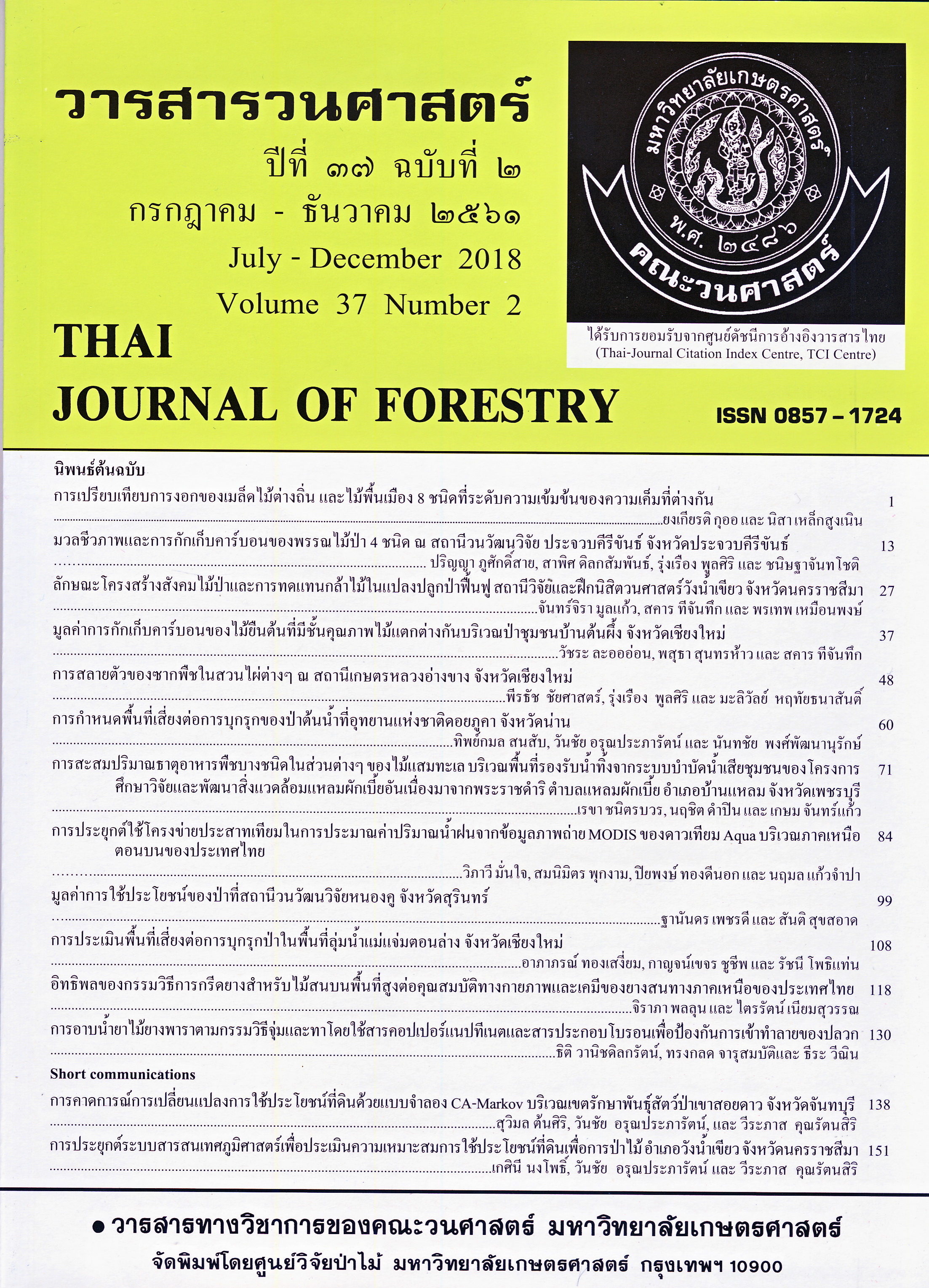การอาบน้ำยาไม้ยางพาราตามกรรมวิธีจุ่มและทาโดยใช้สารคอปเปอร์แนปทีเนตและสารประกอบโบรอนเพื่อป้องกันการเข้าทำลายของปลวก
Main Article Content
บทคัดย่อ
งานวิจัยนี้เพื่อศึกษาการอาบน้ำยาไม้ยางพาราตามกรรมวิธีจุ่มและทาโดยใช้สารคอปเปอร์แนปทีเนต และสารประกอบโบรอนเพื่อป้องกันการเข้าทำลายของปลวก ซึ่งทำการทดลองที่สถานีฝึกนิสิตวนศาสตร์ หาดวนกร จังหวัดประจวบคีรีขันธ์ โดยแผนการทดลองเป็นแฟคทอเรียล 1+2×2×4 จำนวน 20 ซ้ำ ซึ่งใช้การจัดทรีทเมนต์แบบสุ่มสมบูรณ์ (CRD) โดยมีปัจจัยควบคุม คือ ไม้ยางพาราที่ไม่ผ่านการอาบน้ำยา และมีปัจจัยในการทดลอง 3 ปัจจัย คือ 1. การใช้สารประกอบโบรอน ได้แก่ การอาบน้ำยาโบรอน 10% ด้วยวิธีการจุ่ม และไม่มีการอาบน้ำยาโบรอน 2. กรรมวิธีการอาบน้ำยาด้วยสารคอปเปอร์แนปทีเนต ได้แก่ การทา และการจุ่ม 3. ประเภทของการอาบน้ำยาด้วยสารคอปเปอร์แนปทีเนต ได้แก่ สารคอปเปอร์แนปทีเนต 1% ประเภทละลายน้ำ สารคอปเปอร์แนปทีเนต 2% ประเภทละลายน้ำ สารคอปเปอร์แนปทีเนต 1% ประเภทละลายน้ำมัน และสารคอปเปอร์แนปทีเนต 2% ประเภทละลายน้ำมัน จากนั้นนำไม้ยางพาราทั้งหมดไปทำการทดสอบแบบปักดิน ในแปลงทดลองกลางแจ้ง และประเมินผลเมื่อครบระยะเวลา 3 เดือน 6 เดือน และ 9 เดือน
ผลการศึกษาพบว่า ระยะเวลา 3 เดือน 6 เดือน และ 9 เดือน ปัจจัยของไม้ยางพาราที่ไม่มีการเข้าทำลายของปลวก คือ การอาบน้ำยาด้วยสารประกอบโบรอน 10% กับสารคอปเปอร์แนปทีเนต 2% ประเภทละลายน้ำมันด้วยวิธีการจุ่ม ส่วนปัจจัยที่มีการเข้าทำลายของปลวกมากที่สุดในระยะเวลา 3 เดือน 6 เดือน และ 9 เดือน คือ ปัจจัยที่ไม่มีการอาบน้ำยา ซึ่งมีการเข้าทำลายของปลวกเฉลี่ยร้อยละ 4.15 21.45 และ 42.70 ตามลำดับ และปลวกที่เข้าทำลายไม้ยางพาราเป็นปลวก Microcerotermes crassus Snyder วงศ์ Termitidae อันดับ Isoptera
Downloads
Article Details
ข้าพเจ้าและผู้เขียนร่วม (ถ้ามี) ขอรับรองว่า ต้นฉบับที่เสนอมานี้ยังไม่เคยได้รับการตีพิมพ์และไม่ได้อยู่ในระหว่างกระบวนการพิจารณาตีพิมพ์ลงในวารสารหรือสิ่งตีพิมพ์อื่นใด ข้าพเจ้าและผู้เขียนร่วม (ถ้ามี) ยอมรับหลักเกณฑ์และเงื่อนไขการพิจารณาต้นฉบับ ทั้งยินยอมให้กองบรรณาธิการมีสิทธิ์พิจารณาและตรวจแก้ต้นฉบับได้ตามที่เห็นสมควร พร้อมนี้ขอมอบลิขสิทธิ์ผลงานที่ได้รับการตีพิมพ์ให้แก่วารสารวนศาสตร์ คณะวนศาสตร์ มหาวิทยาลัยเกษตรศาสตร์ กรณีมีการฟ้องร้องเรื่องการละเมิดลิขสิทธิ์เกี่ยวกับภาพ กราฟ ข้อความส่วนใดส่วนหนึ่ง หรือ ข้อคิดเห็นที่ปรากฏในผลงาน ให้เป็นความรับผิดชอบของข้าพเจ้าและผู้เขียนร่วม (ถ้ามี) แต่เพียงฝ่ายเดียว และหากข้าพเจ้าและผู้เขียนร่วม (ถ้ามี) ประสงค์ถอนบทความในระหว่างกระบวนการพิจารณาของทางวารสาร ข้าพเจ้าและผู้เขียนร่วม (ถ้ามี) ยินดีรับผิดชอบค่าใช้จ่ายทั้งหมดที่เกิดขึ้นในกระบวนการพิจารณาบทความนั้น”
เอกสารอ้างอิง
ธีระ วีณิน, ทิพย์วิมล สุวรรณโณ และ ทรงกลด จารุสมบัติ. 2560. การศึกษาการอาบน้ำยาไม้ยางพาราเพื่อ ต้านทานไฟด้วยสารประกอบโบรอน. วารสารวนศาสตร์ 36 (1) : 129-135.
เอกพงศ์ เพชรอาวุธ. 2555. ประสิทธิภาพและวิธีการป้องกันไม้ยางพาราจากการเข้าทำลายของปลวกใต้ดินโดยใช้สารประกอบโบรอน. ภาควิชาวนผลิตภัณฑ์ คณะวนศาสตร์ มหาวิทยาลัยเกษตรศาสตร์, กรุงเทพฯ.
Ambuegey, T.L., M.G. Sander and H.M. Barnes. 2016. Evaluating the Efficacy of Borate/Copper Naphthenate Treatments for Protecting Southern Yellow Pine Posts. Mississippi state university, San juan Puerto rico.
American wood protection association standard. 2016. Standard field test for evaluation of wood preservatives to be used in ground contact (UC4A, UC4B, UC4C); stake test. AWPA Technical committee, United state of America.
Brient, J. 2014. Copper Naphthenate Treatment for Wood Crossties and Timbers. Nisus Corporation 100 Nisus Drive Rockford, United state of America.
Su, N.Y. and R.H. Scheffrahn. 1998. A review of subterranean termite control practices and prospect for integrated pest management programs. Integrated Pest Management Reviews 3: 1-13.


